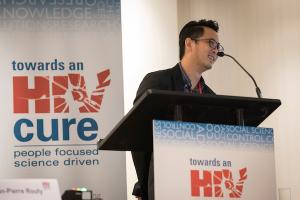Cellular pathway discovered that may re-energize immune cells to eliminate HIV
University of Hawaiʻi at MānoaResearchers at the University of Hawai’i (UH) and Oregon Health Sciences University (OHSU) have revealed a novel new immune pathway that can be targeted to increase the immune system's ability to eliminate HIV, the virus that can lead to AIDS.
The research team led by Lishomwa Ndhlovu, MD, PhD, at the UH John A. Burns School of Medicine (JABSOM) Hawaiʻi Center for AIDS, and Jonah Sacha, PhD, from OSHU, identified a novel negative checkpoint receptor on T cells, TIGIT, which may be responsible for making immune cells dysfunctional and unable to control or eliminate the HIV virus.
The discovery, published in the January 2016 issue of the scientific journal PLoS Pathogens, will give new directions to vaccines and therapies that will potentially reverse these exhausted cells and allow them to control HIV-1 replication, but also serve in “Shock and Kill” HIV curative strategies.
Background
When a person becomes infected with HIV, starting combination antiretroviral drug treatment will, in most cases, successfully suppress HIV in the blood. However, the treatment is powerless to clear infection and restore full health. Furthermore, if people with HIV stop taking antiretroviral drugs, they experience a rapid, aggressive rebound of the virus in the blood. This indicates that HIV has found a way to hide and establish a “dormant reservoir," but more importantly, evade elimination by the immune system.
In the absence of treatment, HIV infection is brought partially under control by the infected person's immune system, specifically by an immune system cell called a CD8+ Killer T cell. The response of these CD8+ T cells and HIV during the early stages of infection is crucial and will determine how the disease will progress. Over time, however, the immune damage mediated by HIV infection will affect the function of the CD8+ T cells, even if with the addition of antiretroviral drugs.
These immune cells are key players in eliminating HIV infected reservoir cells. One proposed strategy to eradicate HIV being considered is the "Shock and Kill" approach, first to "Shock" the infected cells with agents that will awaken the dormant virus and then allow the immune system to "Kill" the reactivated virus. A major obstacle with this approach has been that although CD8+ Killer T cells can recognize HIV-1 infected cells, these T cells are unable to eliminate the reactivated HIV viral reservoir.
“A preponderance of emerging evidence indicates that the functions of the HIV-specific CD8+ Killer T cells are severely compromised and enters a state of ‘exhaustion,’ rendering the cells less effective at eliminating HIV infected cells,” said Glen Chew, a PhD candidate in Immunology at JABSOM and lead author of the study.
According to the World Health Organization (WHO), since the beginning of the epidemic, almost 78 million people have been infected with the HIV virus and about 39 million people have died of HIV. Globally, approximately 35 million people were living with HIV at the end of 2013 and an estimated 0.8% of adults aged 15–49 years worldwide are living with HIV. There is no approved vaccine or curative treatment.
Currently an estimated 2,900 people in the Hawaiian islands are living with HIV/AIDS, with many others unaware of their HIV status. The Hawaiʻi Center for AIDS has launched a fundraising campaign, “Hawaiʻi to Zero” (H20) Initiative, to raise additional resources in its mission to discover a cure for HIV. Learn more about the H20 initiative at: http://hawaii2zero.jabsom.hawaii.edu/
Additional Information:
The research by Chew and his colleagues was supported in part by the National Institutes of Allergies and Infectious Diseases (NIAID) (RO1 AI087145, K24 AI069994), the UCSF Clinical and Translational Research Institute Clinical Research Center (UL1 RR024131), and the CFAR Network of Integrated Systems (R24 AI067039). Additional support came from the National Center for Research Resources (NCCR) grant P51 OD011092 and the NIAID grant P30 AI027763. Funding was also made possible by collaborative efforts of the Office of AIDS Research, the NIAID, and the International AIDS Society (L.C.N.). Additional support was provided in part with federal funds from the NIAID and NIH contract Number NOI-AI-85341. The contents of this publication are solely the responsibility of the authors and do not necessarily represent the official views of the NIH.
For more information, visit: http://hawaii2zero.jabsom.hawaii.edu/


